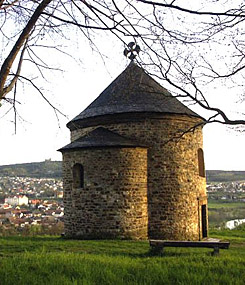
Old Plzenec has repaired the rotunda, probably the oldest in the Czech Republic
 |
The repairs cost approximately 1.7 million crowns. The Plzeň Region contributed one million crowns, Plzeň half a million, and Starý Plzenec also contributed about the same amount. The municipality intends to use the remaining funds to modify the historic hill, the surroundings of the rotunda, and the access path; the remains of the foundations of two nearby churches should also be repaired. In time, they plan to ease the steep access road and establish lookout and rest areas, such as small pavilions. The rotunda should also receive nighttime lighting, similar to another ancient Plzenec landmark, the Radyně Castle.
During several months of reconstruction, the rotunda underwent a complete roof repair - a total replacement of the damaged slate covering, repairs to the framework, and restoration of the cladding across the entire roof area. The rotunda also has newly repaired entrance doors and a new gilded peak called a "sekyrkový" Slavic cross. Damaged masonry joints and the perimeter gutter walkway were also repaired. The interior was also modified.
Although the building has survived centuries, its appearance has changed with successive repairs. "We do not even know exactly how the rotunda looked at the time of its creation," noted Matas.
It probably dates from the second half of the 10th century when the fortified settlement was a lively center before the establishment of Plzeň. However, the building gradually deteriorated, and it apparently collapsed sometime in the 15th century, leaving behind the foundations and walls of the apse. The owners then repaired it in its original shape in the second half of the 16th century, and about two centuries later, it faced the threat of demolition. It was included in the list of religious buildings designated for demolition. It was likely saved from this fate because it was still used as a storage place for gunpowder needed for the construction of the road in the first half of the 19th century.
The town bought the rotunda in 1920, and a few years later, it underwent its first repair; a comprehensive reconstruction then took place in the mid-1970s.
At that time, the rotunda received fortress glass windows, the floor featured copies of the original tiles with Nero and griffins, there was a pseudo-coffered ceiling, new doors covered with copper sheet, and a Renaissance altar table. Since 1975, no major repairs have been done there.
The English translation is powered by AI tool. Switch to Czech to view the original text source.
0 comments
add comment











